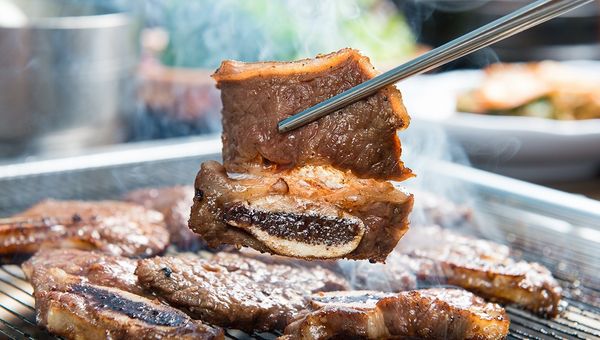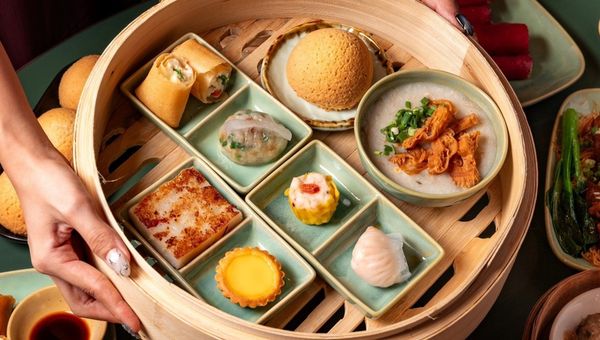Gone are the days when airport dining meant limp sandwiches and mystery meat curries. Across Asia, airports are undergoing a quiet but delicious transformation, becoming culinary destinations in their own right.
With the rise of culinary tourism and the growing desire for more local, immersive experiences, Asian airports are curating dining options that go beyond convenience food – offering everything from Michelin-starred noodles to viral YouTube-famous fried rice.
What to eat in Singapore Changi Airport

Singapore Food Street in Terminal 3 recreates the nostalgic ambience of a 1960s hawker scene, complete with retro décor and a tempting line-up of local favourites. Photo Credit: Changi Airport Group
Consistently ranked among the world’s best airports, Singapore’s Changi Airport is equally ambitious about its F&B offerings.
At Singapore Food Street in Terminal 3, travellers can sample hawker classics like Hainanese chicken rice, satay and chilli crab, while Terminal 1’s Food Gallery serves comforting bowls of bak kut teh and roasted delights.
For a quick local fix, Ya Kun Kaya Toast and Old Chang Kee provide nostalgic flavours with their kaya toast and curry puffs.
Diners looking for something more upscale can enjoy xiao long bao and la mian at Paradise Dynasty or opt for creative rice bowls and sushi rolls at The World is Flat by Tanuki Raw.
What to eat in Tokyo Narita Airport & Haneda Airport

Sushi Kyotatsu at Narita Airport serves premium Edo-style sushi with fresh ingredients from Toyosu Market. Photo Credit: Sushi Kyotatsu
In Tokyo, airports offer more than just fast food – they provide a taste of the country’s rich culinary traditions.
Narita’s Terminal 1 is home to Kyotatsu, renowned for its expertly prepared sushi served with the finesse of a Ginza restaurant. Sanbei dishes up handmade soba with a side of tranquillity, while Mosdo combines Mos Burger’s savoury offerings with the sweet touch of Mister Donut.
At Haneda, Edo Koji recreates the charm of old Tokyo with izakayas, yakitori stalls and ramen joints like Setagaya. From wagyu skewers to delicate wagashi sweets, every dish offers a farewell as refined as the destination itself.
What to eat at Seoul Incheon Airport

Beef galbi is a Korean dish featuring marinated short ribs grilled to perfection, offering a sweet and savoury flavour with tender, smoky meat. Photo Credit: Adobe Stock/Macus
Incheon International Airport has made serious strides in showcasing Korea’s cuisine.
Bibigo Kitchen, the upscale brainchild of Korean food giant CJ and Korean Air, serves refined takes on classic dishes like bibimbap and galbi. There’s also Gooksoo for warm noodle soups, and Kimpo Jip for homestyle Korean eats.
Hanok Bakery offers a sweet fix with Korean rice cakes and egg bread, while Asian Kitchen caters to fusion fans with bulgogi burgers and reimagined tteokbokki. For a regional twist, a Jeju-specialty counter offers hallabong orange confections and pork jerky, giving a taste of the island without needing a separate flight.
What to eat at Hong Kong International Airport

Tim Ho Wan is a Michelin-starred dim sum eatery known for its baked BBQ pork buns, fresh dumplings, and affordable, high-quality Cantonese fare. Photo Credit: Tim Ho Wan
Hong Kong International Airport brings together street food favourites and Michelin-starred bites.
Ho Hung Kee serves up silky wonton noodles and smooth congee that have earned accolades beyond the terminal. Tai Hing’s roasted meats are a hit with locals and visitors alike, while Tim Ho Wan offers renowned dim sum that has made its mark internationally.
For those seeking variety, SkyPlaza’s food court features sizzling claypot rice, dim sum, and fish ball noodles, while popular bakeries like Kee Wah and Honolulu Café offer pineapple buns and flaky egg tarts that capture the city’s snack culture in a bite.
What to eat at Kuala Lumpur International Airport

FUIYOH! It’s UNCLE ROGER is a restaurant in Kuala Lumpur founded by comedian Nigel Ng, known as Uncle Roger, offering his signature fried rice dishes. Photo Credit: Youtube/Guga
KLIA’s evolving food landscape is a reflection of Malaysia’s rich cultural mix. Kitchen by Open House elevates traditional Malay dishes such as Rendang Tok and Lamb Kuzi, while Grandmama’s offers heartwarming staples like nasi lemak, char kway teow, and beef hor fun.
Adding a dash of fun is the newly opened FUIYOH! It’s UNCLE ROGER – a restaurant opened by the viral YouTuber – which puts a cheeky spin on wok hei culture. Meanwhile, Food District at KLIA2 dishes out ayam penyet and Indomie ayam geprek, and over at Hameed Dalca Kopitiam, travellers can tuck into roti canai or mee goreng mamak before takeoff.
A delicious advantage
These airport dining destinations offer more than just convenience – they provide a platform to enhance client journeys from the very start. Whether it’s a pre-departure meal or a mid-journey pit stop, recommending terminal eateries can enrich the travel experience and create memorable food moments even before reaching the hotel.
Travel agents can also offer curated food itineraries within airports: a “last meal in Japan” at Haneda, a “hawker hit list” at Changi, or a “viral food stop” at KLIA. It’s these little extras – recommendations that surprise and delight – that turn a booking into a memorable journey.